What Is EMM – Enterprise Mobility Management? A Brief Introduction
Okt 29, 2021 | 42Gears Team
If you work in a business that uses mobile devices, you have likely seen advertisements for EMM software at some point. Alternately, you may have seen others use this software, or you might even have been asked to use it yourself. In any case, you were likely left asking, "what is EMM?"
What is EMM?
EMM is the ability to manage employee devices as employees do their work, both inside and outside a traditional workplace.
EMM stands for "enterprise mobility management." EMM software is important for anyone looking to bring mobile phones or other devices into the workplace and keep them safe.
Why Does EMM Matter?
EMM software is designed to manage any devices that you give to employees. This includes phones, tablets, and computers. When you set up EMM software, you get access to a central console that you can use to manage devices remotely.
The ability to manage devices remotely is a huge part of EMM. Imagine that you have to update a group of work phones with important firmware. In the past, you would have needed to set aside hours to gather each device and update each one by hand. With enterprise mobility management software, however, you can send that firmware update from the central console to each device wirelessly. This greatly increases convenience and efficiency.
In fact, EMM software is useful across the entire device lifecycle. Whether you need to enroll devices in your network, repair them remotely, or safely retire them, you'll stand to save substantial time using EMM software.
Why call it "enterprise mobility"?
You might find the term "enterprise mobility" a bit confusing. It helps to look at the history of this phrase, so you can understand what the term means.
At one point, cell phones weren't an important part of office productivity. Companies just needed a way to lock them down or restrict functionality. During this time, mobile device management (MDM) software was popular.
However, as smartphones became more common, people began doing more work on their phones. IT admins needed a way to manage the apps and content employees used. In order to address this, the industry shifted to the term enterprise mobility management - in this case, mobility refers to employees doing work on-the-go.
In a literal sense, EMM refers to mobile devices and the apps and content on those devices. As time went on, however, companies saw increasing value in managing every workplace device from a single place - including phones, computers, and other devices like wearables. Officially, EMM is an umbrella term that includes mobile device management, mobile application management (MAM), mobile content management (MCM), and mobile identity management (MIM).
While industry commentators coined the term "unified endpoint management" for this broad approach to device management, EMM remains popular. For this reason, you will often see the term EMM associated with platforms that can manage many types of devices. SureMDM by 42Gears is a good example - while it is technically UEM software, it can also accurately be called EMM software.
EMM and BYOD
Another important aspect of EMM is the ability to support "Bring Your Own Device" programs. In such a program, employees bring their own devices to the office.
BYOD programs can be challenging to implement properly. Businesses need to make sure workers don't use personal devices to compromise work data, but they cannot intrude on workers' personal data. To address this, EMM solutions now include containerization functionality. The EMM makes a virtual box for sensitive work data on an employee device. Now, the business can supervise the apps and content in that box, without interacting with personal data in any way.If you would like to begin implementing an enterprise mobility management solution for your business, you can use SureMDM by 42Gears. It gives you the tools you need to manage any kind of device you have in your office, along with the apps and content your business relies on.
Harness the Power of Enterprise
Mobility Management Today
Subscribe for our free newsletter








